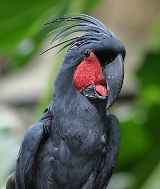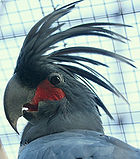
Palm Cockatoo
Encyclopedia

Cockatoo
A cockatoo is any of the 21 species belonging to the bird family Cacatuidae. Along with the Psittacidae and the Strigopidae , they make up the parrot order Psittaciformes . Placement of the cockatoos as a separate family is fairly undisputed, although many aspects of the other living lineages of...
family. It is the only member in subfamily Microglossinae and the only member of the monotypic
Monotypic
In biology, a monotypic taxon is a taxonomic group with only one biological type. The term's usage differs slightly between botany and zoology. The term monotypic has a separate use in conservation biology, monotypic habitat, regarding species habitat conversion eliminating biodiversity and...
genus, Probosciger. Its unique position within the cockatoo family has been confirmed by molecular studies.
Taxonomy
The Palm Cockatoo was originally described by German naturalist GmelinJohann Friedrich Gmelin
Johann Friedrich Gmelin was a German naturalist, botanist, entomologist, herpetologist and malacologist.- Education :Johann Friedrich Gmelin was born as the eldest son of Philipp Friedrich Gmelin in 1748 in Tübingen...
in 1788. Its specific name aterrimus is the Latin
Latin
Latin is an Italic language originally spoken in Latium and Ancient Rome. It, along with most European languages, is a descendant of the ancient Proto-Indo-European language. Although it is considered a dead language, a number of scholars and members of the Christian clergy speak it fluently, and...
superlative adjective for ater "black", hence "very black" or "blackest". It is the earliest offshoot from the ancestors of what have become the cockatoo family.
Description

Yellow-tailed Black Cockatoo
The Yellow-tailed Black Cockatoo is a large cockatoo native to the south-east of Australia measuring 55–65 cm in length. It has a short crest on the top of its head. Its plumage is mostly brownish black and it has prominent yellow cheek patches and a yellow tail band...
s and Sulphur-crested Cockatoo
Sulphur-crested Cockatoo
The Sulphur-crested Cockatoo, Cacatua galerita, is a relatively large white cockatoo found in wooded habitats in Australia and New Guinea. They can be locally very numerous, leading to them sometimes being considered pests...
s broadly overlap in size. It is a distinctive bird with a large crest and has one of the largest bills
Beak
The beak, bill or rostrum is an external anatomical structure of birds which is used for eating and for grooming, manipulating objects, killing prey, fighting, probing for food, courtship and feeding young...
of any parrots (only the Hyacinth Macaw
Hyacinth Macaw
The Hyacinth Macaw , or Hyacinthine Macaw, is a parrot native to central and eastern South America. With a length of about 100 cm it is longer than any other species of parrot...
's is larger). This powerful bill enables Palm Cockatoos to not only eat very hard nuts
Nut (fruit)
A nut is a hard-shelled fruit of some plants having an indehiscent seed. While a wide variety of dried seeds and fruits are called nuts in English, only a certain number of them are considered by biologists to be true nuts...
and seeds, but it also enables males to break off thick (~1") sticks from live trees to use for a drumming display (Wood 1984). The bill is unusual as the lower and upper mandibles do not meet for much of its length, allowing the tongue to hold a nut against the top mandible while the lower mandible works to open it. The Palm Cockatoo also has a distinctive red cheek patch that changes colour when the bird is alarmed or excited.
Distribution and habitat
The Palm Cockatoo is distributed in rainforests and woodlands of New GuineaNew Guinea
New Guinea is the world's second largest island, after Greenland, covering a land area of 786,000 km2. Located in the southwest Pacific Ocean, it lies geographically to the east of the Malay Archipelago, with which it is sometimes included as part of a greater Indo-Australian Archipelago...
island in Indonesia
Indonesia
Indonesia , officially the Republic of Indonesia , is a country in Southeast Asia and Oceania. Indonesia is an archipelago comprising approximately 13,000 islands. It has 33 provinces with over 238 million people, and is the world's fourth most populous country. Indonesia is a republic, with an...
and Papua New Guinea
Papua New Guinea
Papua New Guinea , officially the Independent State of Papua New Guinea, is a country in Oceania, occupying the eastern half of the island of New Guinea and numerous offshore islands...
, and northern Queensland
Queensland
Queensland is a state of Australia, occupying the north-eastern section of the mainland continent. It is bordered by the Northern Territory, South Australia and New South Wales to the west, south-west and south respectively. To the east, Queensland is bordered by the Coral Sea and Pacific Ocean...
, Australia
Australia
Australia , officially the Commonwealth of Australia, is a country in the Southern Hemisphere comprising the mainland of the Australian continent, the island of Tasmania, and numerous smaller islands in the Indian and Pacific Oceans. It is the world's sixth-largest country by total area...
. It still can be found wild and free on the branches of the trees along side the road in Sorong, West Papua, Indonesia.
Calls
The Palm Cockatoo has a large and complex vocal repertoire, including many whistles and even a "hello" call that sounds surprisingly human-like.There are distinct dialects throughout the species' range. It has a unique territorial display where the bird (typically the male) drums with a large (i.e. up to 1" diameter, 15 cm long) stick or seed-pod against a dead bough or tree, creating a loud noise that can be heard up to 100 m away. After drumming, the male occasionally strips the drum-tool into small pieces to line the nest.. Although this drumming behaviour was discovered over two decades ago (in 1984 by G.A. Wood), the reason why palm cockatoos drum is still a mystery. One reason could be that females can assess the durability of the nesting hollow by the resonance of the drumming. Another possibility could be that males drum to mark their territory against other males. Palm Cockatoo is an unusual bird, being that it is an ancient species and one of the few bird species known to use tools.
Breeding
Palm Cockatoos only lay one egg every second year and have one of the lowest breeding success rates reported for any species of parrot. Off-setting this is their very long life-span. A male commenced breeding at age 29 in Taronga Zoo in Sydney, and a female at the London Zoo was 40 when she laid her first egg in 1966. There is anecdotal evidence of a Palm Cockatoo reaching 80 or 90 years of age in an Australian zoo, although the oldest confirmed individual was aged 56 in London ZooLondon Zoo
London Zoo is the world's oldest scientific zoo. It was opened in London on 27 April 1828, and was originally intended to be used as a collection for scientific study. It was eventually opened to the public in 1847...
in 2000. Although longevity of captive birds is known, it is still unknown how long palm cockatoos live in the wild. Breeding takes place inside tree hollows that look like standing pipes. Fires play an important role in the destruction and creation of nest hollows. Fires allow the colonisation of microorganisms and termites, which enter the tree and start hollowing out the inside. Cyclones are important in the final stage of nest hollow development.
Diet
They have a very specific and restricted diet, making them expensive to buy and expensive to own and maintain.Status
The Palm Cockatoo is still relatively common in Cape YorkCape York Peninsula
Cape York Peninsula is a large remote peninsula located in Far North Queensland at the tip of the state of Queensland, Australia, the largest unspoilt wilderness in northern Australia and one of the last remaining wilderness areas on Earth...
, but is threatened there by habitat
Habitat (ecology)
A habitat is an ecological or environmental area that is inhabited by a particular species of animal, plant or other type of organism...
loss, particularly bauxite mining around Weipa and altered fire regimes elsewhere. Palm Cockatoos are hunted in New Guinea. This species is in high demand for the pet trade due to its unusual appearance. The Palm Cockatoo is currently evaluated as Least Concern on the IUCN Red List
IUCN Red List
The IUCN Red List of Threatened Species , founded in 1963, is the world's most comprehensive inventory of the global conservation status of biological species. The International Union for Conservation of Nature is the world's main authority on the conservation status of species...
of Threatened Species. It is listed on Appendix I of CITES.

